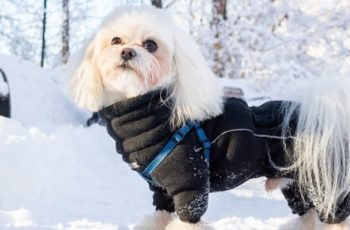Don’t let inclement weather stop you from training: trail running can be a year-round activity for you and your dog! Winter running requires prep work, but snow and ice shouldn’t mean missing months of workouts. Instead, focus on investing in the right gear for you and your dog and making a plan for safety. Here’s how to trail run in the winter with your dog:
Safety Always
Trails tend to be in more isolated spots. Unlike most road runs where you’re likely to pass other people, cars, and homes—and could rely on those passing strangers in a real emergency—on a trail you need to be self-reliant. Remember, your dog relies on you as well. No matter the conditions, always plan for safety. A few examples: tell someone where you’re going and when you expect to return. Pack enough supplies, more on that in a minute, for both you and your dog. Anticipate the best but plan for the worst.
Watch the Weather
It seems obvious, but check the hourly forecast before you get dressed. The clothes you and your dog wear must be adjusted for the climate. Runners get caught off-guard too often by a sudden snow or wind event. If you know what you’re facing, you can gear up appropriately and get your dog prepared for the elements. Does she need boots today? A base layer? Know before you go.
Get the Gear
Winter-appropriate gear allows you and your dog to train harder and longer in cold weather. Layers are key for you, and your dog needs the right harness, coat, and boots. Invest in high-quality gear that will last and will keep you and your pup safe on the trails. A basic running belt like the K9 Excursion works for short runs, but we recommend packing more water and food than you anticipate for an icy trail in case of accident, injury, or slow-down due to conditions. The Canicross Running Belt might be a better pick for winter runs.
Hydrate
We’re conditioned to take water on long, hot trail runs, but it’s actually just as important to hydrate on cold runs. Unfortunately, a common mistake is packing not enough water to account for you and your dog on a winter run. The fix? Estimate how much you think you’ll both need, then multiply it by two. It might feel excessive, but in case of difficult terrain, a missed turn, or an injury, you and your dog will be hydrated. If you’re using a belt like those above, you have a good start. The Gourd is another favorite and includes a bowl for your dog. If your dog wears a backpack, stow extra water for you both in his satchels.
Finally, don’t forget to allow recovery time for you and your dog. Running trails in winter can be harder on your joints and skin, so take breaks between training runs. With the right gear and the right plan, you and your dog won’t miss months of training, and you’ll get to experience the joy that comes with cutting quiet winter trails together!


